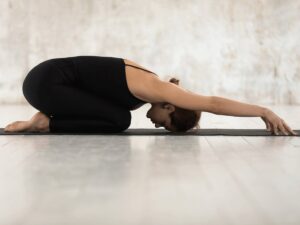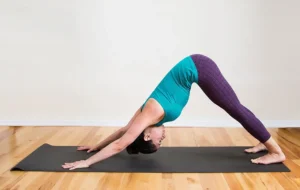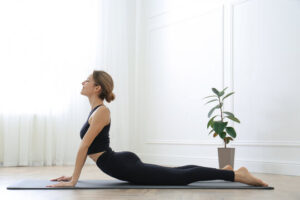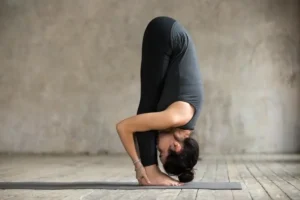Flexibility is a crucial component of physical health, and yoga is an excellent way to improve it. Whether you’re a seasoned yogi or a beginner, these top 5 yoga exercises for flexibility can help you enhance your range of motion, reduce the risk of injury, and promote overall well-being.
1) Child’s Pose (Balasana) (Yoga Exercises For Flexibility)

Child’s Pose (Balasana) is a gentle and restorative yoga pose that helps stretch the lower back, hips, thighs, and ankles while promoting relaxation. Here’s how to do it step by step: (Yoga Exercises For Flexibility)
1)Starting Position:
Begin by kneeling on the floor with your big toes touching and your knees hip-width apart.
2)Sit Back:
Sit back on your heels, allowing your buttocks to rest on your heels.
3)Extend Arms:
Reach your arms forward and stretch them out in front of you on the floor. Your palms should be resting flat on the mat or the ground.
4)Lower Your Torso:
Gently lower your torso towards the ground so your chest and forehead rest on the mat. Your arms should be extended fully, and your hands should be relaxed. (Yoga Exercises For Flexibility)
5)Relax Your Neck:
Let your forehead rest on the mat, and relax your neck, allowing it to lengthen. Ensure that your head and neck are in a neutral position.
6)Breathe:
Take slow, deep breaths, and try to sink deeper into the pose with each exhalation. You can also focus on relaxing any tension in your back, hips, and shoulders.
7)Hold the Pose:
Stay in Child’s Pose for as long as you like, typically 1-3 minutes or more. It’s a restorative pose, so feel free to take your time and enjoy the relaxation. (Yoga Exercises For Flexibility)
8)Exit the Pose:
To leave the pose, gently walk your hands back towards your body, slowly lifting your torso, and sit back on your heels.
2) Downward-Facing Dog (Adho Mukha Svanasana)

Downward-Facing Dog, or Adho Mukha Svanasana in Sanskrit, is a famous yoga pose that stretches and strengthens the entire body. Here’s how to do it step by step:
1)Starting Position:
Begin on your hands and knees in a tabletop position, with your wrists directly under your shoulders and your knees under your hips.
2)Hand Placement:
Spread your fingers wide, pressing your palms firmly into the mat. Your middle fingers should point forward, and your hands should be shoulder-width apart. (Yoga Exercises For Flexibility)
3)Tuck Your Toes:
Tuck your toes under and lift your hips toward the ceiling.
4)Straighten Your Legs:
Start straightening your legs, but it’s okay if they’re not straight. Keep a slight bend in the knees if needed.
5)Lengthen Your Spine:
Press through your hands, lifting your sitting bones toward the ceiling. At this point, your body should resemble an inverted “V” shape.
6)Engage Your Core:
Draw your navel in towards your spine to engage your core muscles.
7)Heels Toward the Floor:
Try to lower your heels toward the ground. They may not touch the floor, especially if you’re a beginner, so don’t force them. The goal is to feel a stretch in your calves and hamstrings. (Yoga Exercises For Flexibility)
8)Head Position:
Your head should be between your upper arms, and your neck should be relaxed. Gaze toward your feet or navel.
9)Breathe:
Take deep breaths in this Position, feeling the stretch in your back, hamstrings, and shoulders. Relax into the pose.
10)Hold the Pose:
Stay in Downward-Facing Dog for 5 to 10 deep breaths or longer if you’re comfortable.
11)Exit the Pose:
To come out of the pose, bend your knees, lower your hips, and return to the tabletop Position on your hands and knees.
3) Cobra Pose (Bhujangasana) (Yoga Exercises For Flexibility)

Cobra Pose, or Bhujangasana in Sanskrit, is a yoga pose that stretches and strengthens the back, particularly the lower back and the spine. Here’s how to do it:
1)Starting Position:
Begin by lying on your stomach on a yoga mat with your legs extended and the tops of your feet resting on the mat.
2)Hand Placement:
Place your hands on the mat, palms down, alongside your shoulders. Your fingertips should align with your shoulders, and your elbows should be tucked close to your body. (Yoga Exercises For Flexibility)
3)Engage Your Core:
Engage your core muscles by drawing your navel toward your spine.
4)Inhale and Lift Your Chest:
As you inhale, gently press your hands into the mat and lift your chest off the ground. Keep your elbows slightly bent. Use the strength of your back muscles, not your arms, to lift your chest.
5)Lengthen Your Neck:
Keep your neck long and neutral, looking forward or slightly upward. Avoid crunching your neck or straining it.
6)Maintain Hip Contact:
Keep your pelvis and hips in contact with the mat. Your lower body, from your pelvis down, should stay on the ground.
7)Breathe:
Take deep breaths as you hold the pose, feeling the stretch in your spine and chest. (Yoga Exercises For Flexibility)
8)Hold the Pose:
Hold Cobra Pose for 15-30 seconds, or as long as is comfortable for you. You can gradually increase the duration as you become more flexible and robust.
9)Exhale and Lower:
Exhale and slowly lower your chest back down to the mat.
10)Rest:
After releasing the pose, turn your head to one side and rest briefly before moving into your next pose.
4) Forward Fold (Uttanasana)

Forward Fold, or Uttanasana in Sanskrit, is a yoga pose that stretches the entire back of the body, including the spine, hamstrings, and calves. It’s an excellent pose for promoting flexibility and relaxation. Here’s how to do it: (Yoga Exercises For Flexibility)
1)Starting Position:
Begin in a standing position with your feet hip-width apart. Ensure that your weight is evenly distributed on both feet.
2)Relax Your Body:
Take a moment to relax and stand tall. Roll your shoulders back and down, and let your arms hang by your sides.
3)Inhale:
Inhale as you lengthen your spine and engage your core muscles.
4)Exhale and Bend Forward:
Exhale as you hinge at your hips and bend forward from your waist. Keep your back straight as long as possible.
5)Hands to the Floor:
Reach your hands down toward the floor. Depending on your flexibility, your hands may reach the bottom, shins, or thighs. You can also use yoga blocks if the floor is too far away. (Yoga Exercises For Flexibility)
6)Relax Your Neck:
Let your head hang heavy and relax your neck. Your gaze should be toward your legs or the floor.
7)Bend Your Knees (Optional):
If your hamstrings are tight or you’re a beginner, you can slightly bend your knees to ease the stretch. As you progress, work on straightening your legs.
8)Hold the Pose:
Hold the Forward Fold for 30 seconds to a minute or longer, focusing on deep, steady breaths and relaxing into the stretch.
9)Inhale and Return:
To come out of the pose, inhale as you slowly roll up one vertebra at a time, lifting your torso until you’re back in a standing position.
10)Rest:
Stand tall and take a few breaths to centre yourself before moving on to your next yoga pose. (Yoga Exercises For Flexibility)
5) Seated Forward Bend (Paschimottanasana)

Seated Forward Bend, or Paschimottanasana in Sanskrit, is a yoga pose that provides a deep stretch to the entire back of the body, particularly the hamstrings and spine. Here’s how to do it:
1)Starting Position:
Sit on the floor with your legs extended straight in front of you. Your toes should be flexed, pointing toward the ceiling.
2)Sit Up Straight:
Sit up straight and engage your core muscles. Lengthen your spine by reaching the crown of your head toward the ceiling.
3)Inhale:
Inhale deeply, lifting your arms overhead and extending your spine.
4)Exhale and Bend Forward:
Exhale as you hinge at your hips, keeping your back straight, and reach forward with your hands. Lead with your chest, not your head, and keep your neck aligned with your spine. (Yoga Exercises For Flexibility)
5)Hold Your Legs:
Reach for your legs, ankles, or feet, depending on your flexibility. If you can’t reach your feet, you can use a yoga strap or a towel looped around your feet to help you get.
6)Relax Your Neck:
Let your head hang heavy and relax your neck. Your gaze should be toward your legs or the space between your knees.
7)Breathe:
Take slow, deep breaths as you hold the pose. With each exhalation, you can try to deepen the stretch by pulling yourself closer to your legs.
8)Hold the Pose:
Hold the Seated Forward Bend for 30 seconds to a minute or longer if comfortable.
9)Inhale and Return:
To leave the pose, inhale and lift your torso back up, maintaining a straight back. (Yoga Exercises For Flexibility)
10)Rest:
Sit up straight again, take a few breaths to relax and centre yourself, and then move on to your next yoga pose.
Incorporate these yoga exercises into your routine to enhance your flexibility gradually. It’s essential to practice patience and mindfulness, honouring your body’s current limits. (Yoga Exercises For Flexibility)
Flexibility takes time to develop, so be consistent, and you’ll notice positive changes. Remember to breathe deeply and focus on your body’s sensations as you perform these poses. Flexibility is not just about physical progress; it’s also about finding balance and peace within yourself. Happy stretching!
